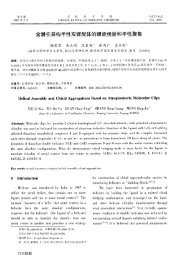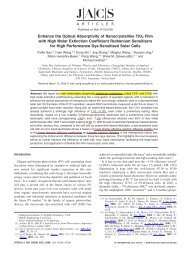Hydrothermal Synthesis of Phosphate-Functionalized Carbon ...
Hydrothermal Synthesis of Phosphate-Functionalized Carbon ...
Hydrothermal Synthesis of Phosphate-Functionalized Carbon ...
You also want an ePaper? Increase the reach of your titles
YUMPU automatically turns print PDFs into web optimized ePapers that Google loves.
ACS Applied Materials & InterfacesResearch ArticleFigure 4. (a) XPS survey spectrum <strong>of</strong> the C2HC-700 sample and deconvoluted high-resolution (b) C1s, (c) O1s, and (d) P2p spectra <strong>of</strong> the C2HC-700 sample.Table 2. Deconvolution Results <strong>of</strong> XPS Spectra <strong>of</strong> theC2HC-700 Sampleregioncontent(at %)position(eV)assignmentpercentage(%) aC1s 89.6 283.9 carbide 6.8284.6 graphite 55.7285.4 R−OH + C−O−C +C− 17.5O−P286.5 CO +>CO 10.3288.9 COOH + −C(O)−O−C 7.5291.2 π−π* 2.2O1s 8.0 530.3 quinones 12.3531.6 =O 24.7532.6 −O− 35.4533.6 OH 27.6P2p 2.5 133.2 phosphates and100pyrophosphatesa Relative percentage <strong>of</strong> each component deconvoluted from the highresolutionXPS spectra <strong>of</strong> C1s, O1s, and P2p.sample was also heated at 800 and 900 °C under nitrogen atmosphereto yield C2HC-800 and C2HC-900 samples.2.2. Characterizations. Morphologies and microstructures <strong>of</strong>carbon composites were examined by a field emission scanningelectron microscopy (FE-SEM, FEI NOVA NanoSEM 450, operatedat 3 kV) and a transmission electron microscopy (TEM, Philips TecnaiG220, operated at 120 kV). Specific surface area and pore sizedistribution were calculated based on the nitrogen physical sorption(Micromeritics ASAP 2020). The composites were degassed at 200 °Cfor 5 h prior to the nitrogen sorption measurement. A Fouriertransform infrared (FTIR) microspectroscopy (Thermo ScientificNicolet iN10) was used to investigate to surface properties. Thermogravimetricanalysis (TGA, Mettler Toledo 851e) was conducted in air fromroom temperature to 850 °C atarate<strong>of</strong>10°C min −1 .TheX-rayphotoelectron spectroscopy (XPS, Thermo ESCALAB 250) measurementwas performed to analyze the surface properties quantitatively. Theelectrical conductivities were calculated according the results measured bythe four-probe method using a S-2A four-probe station and Keithley 2400Sourcemeter.2.3. Electrochemical Measurements. The cyclic voltammetry,galvanostatic charge−discharge, electrochemical impedance spectroscopy(EIS) and galvanostatic cycling test were carried out using CHI660D (Shanghai Chenhua, China) electrochemical workstation in athree-electrode cell with 6 M KOH as electrolyte solution. Activematerials and binder poly(tetrafluoroethylene) with a mass ratio <strong>of</strong>95:5 were pressed onto the nickel foam that were used as the workelectrode. Hg/HgO electrode and Pt foil electrode were used asreference electrode and counter electrode in the three-electrode cell,respectively. Cyclic voltammetry and galvanostatic cycling stability testwere also carried out in the two-electrode cell assembled by twosymmetrical work electrode at different cell voltages. The cell wasoperated at cell voltage <strong>of</strong> 0.9 V for the first 5000 cycles followed byanother 5000 cycles at a cell voltage <strong>of</strong> 1.2 V and a current density <strong>of</strong>5Ag −1 for cycling test.3. RESULTS AND DISCUSSIONFunctional carbon composites with hierarchical porousstructure were prepared by a simple one-pot s<strong>of</strong>t-templatehydrothermal reaction <strong>of</strong> copolymer, CNTs, fructose, andH 3 PO 4 followed by heat treatment. In this approach, as shownin Scheme 1, triblock copolymer Pluronic P123 has dualfunctions, i.e., to help disperse CNTs uniformly and serve asmesopore template where carbonaceous sol intermediates2106dx.doi.org/10.1021/am303052n | ACS Appl. Mater. Interfaces 2013, 5, 2104−2110
















